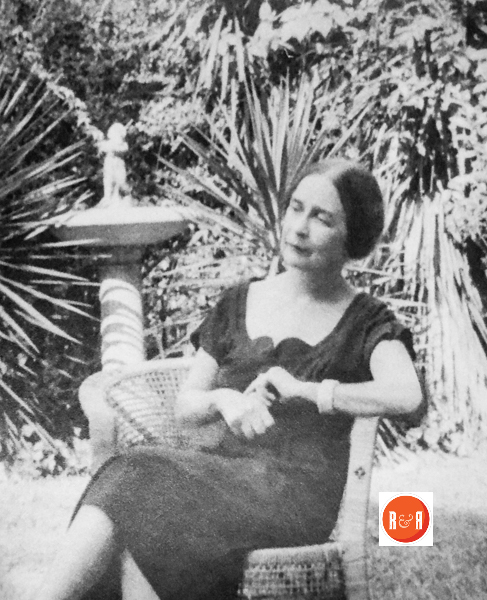City Directories and History: The Earle Town House is an architectural, historical, and aesthetic asset. An architecturally distinguished example of a late Georgian dwelling, one of the few extant in upper South Carolina, the residence is one of two houses within Greenville remaining from the city’s earliest history. Its park-like grounds, shaded by old trees and enclosed by an ivy-covered grillwork fence, feature the sanded front walk typical of its earlier years, a handsome garden front entrance of grillwork and brick, and an ivy mound approximately 100 years old (built after 1856). A rear garden with fountain is patterned after Edgar Allen Poe’s Richmond, Virginia garden. That the home now known as the Earle Town House was built at least by 1810 is indicated by the 1910 birthday
celebration marking its 100th anniversary. Outstanding features include distinctive wood and glass detailing surrounding the front door, double front steps, a Palladian window on the second story, hand carved mantels, six paneled doors, and raised paneled dado. The Earle House site was originally part of the plantation of the pioneer Earle family. The family came from Virginia shortly after the Revolution and settled in this wooded, Blue Ridge foothills section. Elias T. Earle, whose father was an early member of the Virginia House of Burgesses, was one of the first members of the family in South Carolina, figuring prominently in the history and development of the Greenville area and of the state. He was a state senator from Greenville District, a U.S. Congressman, a silk grower, a manufacturer, and first Commissioner of Indian Affairs under the U.S. government. Also born in the house was another leading figure, Judge and U.S. Senator Joseph Haynsworth Earle, great grandson of Elias T. Listed in the National Register August 5, 1969.
View the complete text of the nomination form for this National Register property(Courtesy of South Carolina Department of Archives and History)
“Significant Greenville houses on the Register include the two in-town residences credited with being the city’s oldest: Earle Town House (c. 1810) at 107 James Street, home of South Carolina writer, Mary Simms Oliphant, and Whitehall (c. 1813) at 310 West Earle Street, the C. B. Dawsey residence. Both were built on the original
plantation lands of the pioneer Earle family who came from Virginia shortly after the Revolution, and both retain a park-like atmosphere with tree-shaded grounds and walkways. The Earle House was the homesite of Elias T. Earle, state senator from Greenville District, U.S. Congressman, silk grower, manufacturer, Commissioner of Indian affairs. Nearby Whitehall was built as a summer residence by distinguished Charlestonian Henry Middleton on land purchased from Elias Earle in 1813.”
Also: Significant Greenville houses on the Register include the two in-town residences credited with being the city’s oldest: Earle Town House (c. 1810) at 107 James Street, home of South Carolina writer, Mary Simms Oliphant, and Whitehall (c. 1813) at 310 West Earle Street, the C. B. Dawsey residence. Both were built on the original plantation lands of the pioneer Earle family who came from Virginia shortly after the Revolution, and both retain a park-like atmosphere with tree-shaded grounds and walkways. The Earle House was the homesite of Elias T. Earle, state senator from Greenville District, U.S. Congressman, silk grower, manufacturer, Commissioner of Indian affairs. Nearby Whitehall was built as a summer residence by distinguished Charlestonian Henry Middleton on land purchased from Elias Earle in 1813.
Information from: Names in South Carolina by C.H. Neuffer, Published by the S.C. Dept. of English, USC
Stay Connected
Explore history, houses, and stories across S.C. Your membership provides you with updates on regional topics, information on historic research, preservation, and monthly feature articles. But remember R&R wants to hear from you and assist in preserving your own family genealogy and memorabilia.
Visit the Southern Queries – Forum to receive assistance in answering questions, discuss genealogy, and enjoy exploring preservation topics with other members. Also listed are several history and genealogical researchers for hire.
User comments welcome — post at the bottom of this page.

R&R HISTORY LINK: Cotton was shipped by the Earle family to the Broad River by wagon and loaded on to flat boats owned and operated by Wm. Kelly, 1820s – 1860.
Please enjoy this structure and all those listed in Roots and Recall. But remember each is private property. So view them from a distance or from a public area such as the sidewalk or public road.
Do you have information to share and preserve? Family, school, church, or other older photos and stories are welcome. Send them digitally through the “Share Your Story” link, so they too might be posted on Roots and Recall.
Thanks!





